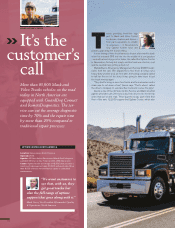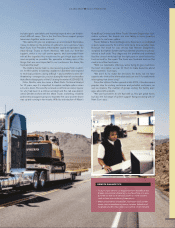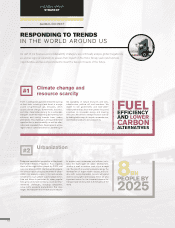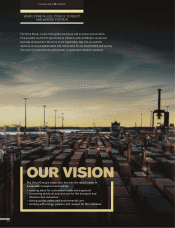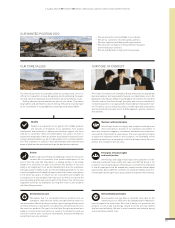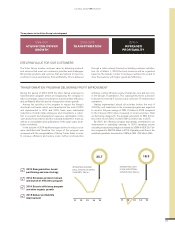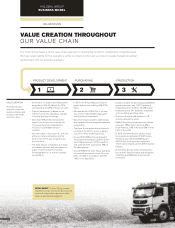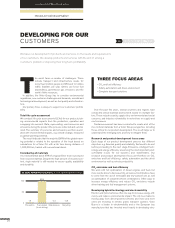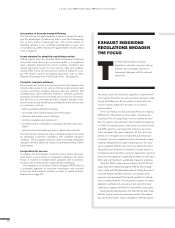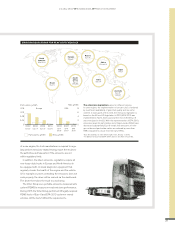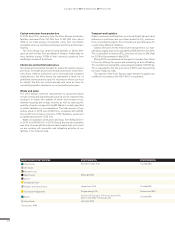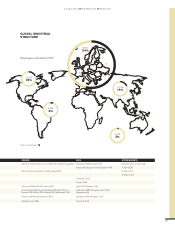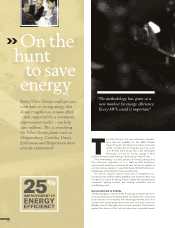Volvo 2015 Annual Report Download - page 28
Download and view the complete annual report
Please find page 28 of the 2015 Volvo annual report below. You can navigate through the pages in the report by either clicking on the pages listed below, or by using the keyword search tool below to find specific information within the annual report.
The world faces a number of challenges. These
include transport and infrastructure needs for
more than 9 billion people in 2050 and 1.2 million
traffic fatalities per year. Others are fossil fuel
dependency, greenhouse gas emissions and the
earth’s finite resources.
In addition, the Volvo Group has to consider environmental
regulations, new customer challenges and demands, societal and
technological development, as well as fuel quality and infrastruc-
ture.
Our primary focus is always to support our customers’ profita-
bility.
Total life cycle assessment
We conduct life cycle assessments (LCAs) for our products, tak-
ing environmental impacts from the production, operation and
scrapping into account. Data, representing used resources and
emissions during the product life cycle, are collected and summa-
rized. The summary of resources and emissions are then associ-
ated with environmental impacts, e.g. climate change, measured
as global warming potential.
The result indicates that the majority (98%) of the global warm-
ing potential is related to the operation of the truck based on
calculations for a Volvo FH with a life time driving distance of
1,000,000 km, fuelled with conventional diesel.
Considering all materials
It is estimated that about 45% of a typical Volvo truck is produced
from recycled material. Despite the high amount of recycled con-
tent, virgin material is still needed to ensure quality, availablility
and durability.
DEVELOPING FOR OUR
CUSTOMERS
We base our development of products and services on the needs and requirements
of our customers. We develop products and services with the aim of solving a
customer’s problem or improving their long-term profitablility.
THREE FOCUS AREAS
• CO2 and fuel efficiency
• Safety, automation and driver environment
• Complete transport solutions
Over the past few years, several countries and regions have
conducted critical material assessments based on multiple fac-
tors. These include scarcity, supply risks, environmental and social
concerns, and industry vulnerability to restrictions on supply and
cost increases.
Similar assessment has been conducted to create a list of the
most critical materials from a Volvo Group perspective, including
those critical to our product development. The result helps us to
understand the emerging risks and how to mitigate them.
Research and product development focus areas
Each stage of our product development process has different
objectives e.g. financial, quality and reliability, that need to be met
before proceeding to the next stage. Emissions, intelligent tech-
nology and energy efficiency are among the most important prod-
uct-related issues for our business and stakeholders. Our
research and product development focus are therefore on CO2
emissions and fuel efficiency; safety, automation and the driver
environment as well as vehicle productivity.
CO2 emissions and fuel efficiency
We work with full optimization of diesel engines and fuels but
more can be done to decrease CO2 emissions. Contributions have
to come from the use of renewable and low-carbon fuels as well
as optimization of complete vehicle combinations. Other ways to
increase energy efficiency and reduce CO2 emissions include
driver training and fuel management systems.
Developing hybrid technology and electromobility
Electric and hybrid vehicles offer one way to increase energy effi-
ciency and reduce environmental impact. The city bus market is
moving away from diesel-powered vehicles and more and more
cities are investing in electric public transport systems. Volvo
Buses is a leader in electromobility and is the European bus
manufacturer that has invested most heavily in developing elec-
A GLOBAL GROUP BUSINESS MODEL
PRODUCT DEVELOPMENT
GLOBAL WARMING POTENTIAL, % (100 YEARS PERSPECTIVE)
Production
1.9
98.4
0.3 –0.6
Fuel related
(truck driving)
Maintenance Recycling
100
50
0
26


